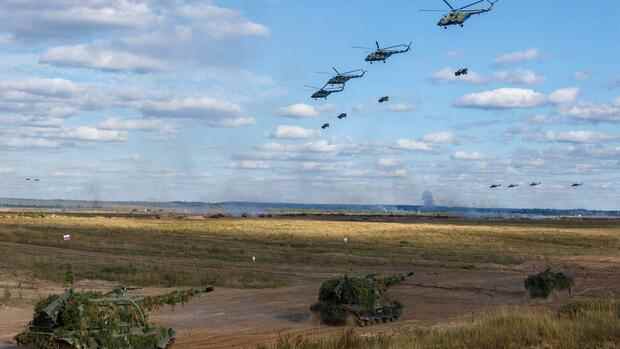Moscow Instead of the red telephone, the “red video chat” is celebrating its premiere: a secure internet connection between Moscow and Washington at the highest level. This connection existed before, said Kremlin spokesman Dmitri Peskov. “So far, it has only been tested in operating mode, but not used by the heads of state.” That will change this Tuesday during a conversation between US President Joe Biden and his Russian counterpart Vladimir Putin.
The red telephone, a permanent telex connection between the United States and the Soviet Union, was established after the 1962 Cuban Missile Crisis, which almost led the world into nuclear war. So now the red video chat, because the sounds in the current crisis are almost as shrill as in the heyday of the Cold War.
In view of the Russian troop deployment with around 100,000 soldiers near the Ukrainian border, military experts in Washington and Kiev are warning of the risk of a Russian invasion of Ukraine.
Before the summit, information leaked about possible US sanctions. They range from restrictions on the sale of Russian government bonds to Russia’s shutdown from the Swift international banking system.
Top jobs of the day
Find the best jobs now and
be notified by email.
These punitive measures would be a huge burden for Moscow. Investors are already frightened by the current crisis in diplomatic relations and speculation about sanctions. The prices on the Russian stock exchange had fallen accordingly in the past few days. Despite these costs, Vladimir Putin is currently risking escalation. There are five reasons.
1. Moscow fears a Kiev offensive in Donbass
Not only the Russian army has concentrated troops around Ukraine. The leadership in Kiev has recently increasingly concentrated its military in the Donbass region. The Russian Foreign Office spokeswoman Maria Sakharova recently claimed that “half of the Ukrainian troops”, ie 125,000 soldiers, are now stationed there. There is no independent confirmation of the figures.
Russian President does not want to allow Ukraine to launch an offensive in Donbass.
(Photo: AP)
Nevertheless, the fear of an escalation in Donbass is not entirely unfounded. The rhetoric in Kiev has become sharper, and military activities have recently increased again in Donbass. And not just by the separatists. The headlines were made about a month ago when the Ukrainian military captured the village of Staromaryevka. The village is in the gray area and should actually be demilitarized.
From here it is only 30 kilometers to the Russian border. Strategically, the Ukrainian military could advance at this point to drive a wedge between the pro-Russian separatist forces and then individually conquer the southern and northern parts. Moscow will not allow that.
“She will have to answer for any aggression against Russians in Donbass. Ukraine will lose the military, its territory and its current political system, ”threatened Duma deputy Andrei Kolesnik, who, as a veteran of a special unit of the Russian fleet, is familiar with the thinking of the military leadership.
2. Putin wants to tire Ukraine – for him it is part of his “Russian world”
The deployment of troops does not only serve to deter Kiev from plans to retake it. Because Putin keeps deploying the military on the border. Extensive maneuvers took place in the region as early as spring. So he keeps his opponent constantly on the alert.
Putin’s strategy: The constant alert could lead to signs of fatigue on the other side. Russia’s resources are greater than those of Ukraine, which could collapse under pressure.
In principle, the Kremlin is sticking to its idea of “Russki Mir” – translated as Russian world. Ukraine definitely belongs to this sphere of influence, even if the Kremlin wants to avoid a military takeover if possible.
3. Russia wants to avoid further NATO expansion to the east
What the Kremlin wants to prevent at all costs is an expansion of NATO to the east. That is why Putin recently made it clear that receiving written guarantees to stop NATO expansion was the most urgent goal. Russia sees its security interests threatened by NATO expansion to the east.
Ukraine’s accession to NATO is a red line that the West must not cross, according to the position in Moscow. Putin is also using the current escalation as a means of pressure in the negotiations to enforce his position.
4. Putin wants to negotiate on an equal footing with the USA
Putin has already achieved another goal with the crisis. Russia and the USA are sitting together at the negotiating table. Washington has offered to act as a mediator in the Ukraine crisis. While Barack Obama dismissed Russia as a “regional power”, his then Vice-President Biden is now forced to negotiate spheres of influence with Putin.
Rumors of an annexation of the Donbass region on the part of Russia have been growing louder in the last few days.
(Photo: via REUTERS)
Russia sees this as confirmation of its status as a great power, as it has always insisted on speaking “on an equal footing” with the USA. In addition to Ukraine, other international crises such as Afghanistan, Syria and Libya, but also the deadlocked bilateral relations between Russia and the USA will come on the table.
5. The Kremlin is using Ukraine as a diversionary maneuver from massive domestic political problems
Western diplomats have recently noticed that Russia is increasingly pursuing its foreign policy from a domestic perspective. The Ukraine crisis is perfect for this. For years, the enemy image of Ukraine has been built up in Russia as a Nazi stronghold – regardless of the fact that Volodimir Zelensky, a president of Jewish origin, is in office there.
The reference to the socially weak, sometimes politically wandering Ukraine allows the Kremlin to divert attention from its own problems. And there are enough of them: From the fiasco in the corona crisis to the weak economy and falling real incomes.
More: Biden wants to threaten Putin with tough sanctions in the Ukraine conflict
